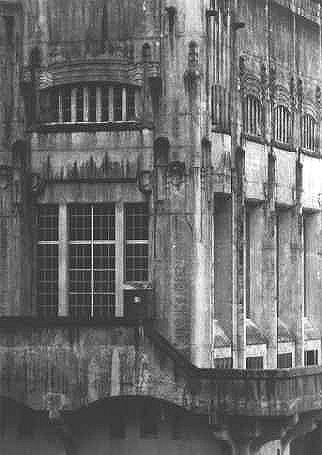Ruskin, British Columbia

Photo: Mike Cleven
Ruskin is a rural and industrial area about 40 kilometres east of Vancouver, British Columbia straddling the border between the suburban municipalities of Maple Ridge[1] and Mission, on the west bank of the lower Stave River.
History
The name originated with the first settlement of the area by followers of English art critic and essayist, John Ruskin, the theorist of the Gothic Revival and an advocate of "gentlemanly socialism" and dedication to crafts and rural industry, similar to the pre-Raphaelites and some of the Fabianist groups. The erstwhile Ruskinite commune failed within a few years but the name remained. About 20 years after the failure of their colony, the area was bisected by newly created school districts which were copied by the later municipal partition of the area.
Several lumber mill operations thrived at Ruskin, mostly cedar shake mills, including some of the highest-volume operations in the world (the largest being at nearby Whonnock and in Mission City), drawing on the gigantic trees of the Stave River basin. Some logging operations in the area were owned and run by Japanese Canadians until their expropriation in World War II, and evidence of Japanese-style logging activity such as corduroy roads can still be found in the surrounding forests.
Located two miles upstream from the Stave's confluence with the Fraser is Ruskin Dam, the newest and largest of the three powerhouses comprising the output the Stave River power development, which supplied power to the British Columbia Electric Railway (BCER) and electrical power to the growing metropolis at Vancouver.
The power project was originally begun at Stave Falls, four miles further upstream. The newer dam power plant at Ruskin was opened in 1931, and forms Hayward Lake. Once Ruskin's generating power was online, the Stave River project contributed the bulk of Greater Vancouver's power until the completion of the Bridge River Power Project near Lillooet in 1961. Touted at the time as a wonder of modern architecture, it follows the British Columbia Electric Railway Company's penchant for Classical Revival, but indulges in neo-Gothic motifs in tribute to John Ruskin, and has an additional art deco flavour.
An electric railway separate from the main passenger operations of the BCER, known as the Stave Valley Branch ran between the CPR mainline and the dam at Stave Falls; this was relocated to a higher elevation with the creation of Hayward Lake, and the ruins of many of its trestles line the western shore of that reservoir; the rail grade has been converted into a hiking and biking trail in recent times. Between the dam and the sawmills there was a drive-in theatre located on the banks of the Stave River until about 1970; it was converted into a large trailer park adjoining the older houses of the millworking community attached to the mills. These, and some of the mill sites and offshore islands and marshes, comprise Langley Indian Reserve No. 2 and Langley Indian Reserve No. 3. Across the main flow of the Stave, adjacent to Highway 7 and west of the causeway forming Silvermere Lake, is Langley Indian Reserve No. 4. All are under the governance of the Kwantlen First Nation, whose offices are located in Fort Langley.[2]
Schools
Students from the part of Ruskin in Maple Ridge are served by School District 42 Maple Ridge-Pitt Meadows and it has an elementary school called Ruskin Elementary School. Those from the parts of Ruskin in the District of Mission attend Silverdale Elementary School in Silverdale.
Businesses
Ruskin has many businesses including; Shake and Shingle Pub, Cuts N' Cuddles, Thompson Creek Farms, Cardinal Business Services and Big Mikes Fun Farm as well as several sawmills and the Ruskin Store and Gas Station
Popular culture
Ruskin Dam and the bridge to the powerhouse were featured sets in the X-Files (chapters 'Patient X' and 'The Red and The Black' of Season Five). It was called Reeves Dam used in episodes of Smallville: "Prototype", "Phantom" and "Bizarro", where Clark Kent confronts Bizarro.
It was also seen in an episode of MacGyver (Season 5, episode 8) and in the movie The Invisible starring Justin Chatwin.
References
- Cherrington, John A. Mission on the Fraser, Mitchell Press, Vancouver (1974). ISBN B0006CL344
- Miller, Charles A. Valley of the Stave, Hancock House, Vancouver (1981) ISBN 0-88839-121-8
- Schroeder, Andreas. Carved from Wood: Mission, B.C. 1861-1992, The Mission Foundation, Mission BC (1992) ISBN 1-55056-131-6
- Stanley, Meg and Wilson, Hugh. Station Normal: The Power of the Stave River, Douglas & McIntyre, Vancouver (2001) ISBN 1-55054-932-4
See also
- John Ruskin
- Ruskin, Florida
- Ruskin Colony (Tennessee)
External links
- Ruskin Community Website
- Map of Stave Valley Branch, British Columbia Electric Railway
- BC Hydro Ruskin Dam Recreation Site
- BC Hydro Recreation page on Hayward Lake
- Ruskin page, Maple Ridge Museum and Community Archives website
- Flickr gallery "Ruskin", Maple Ridge Community Association
References
| |||||||||||||||||
Coordinates: 49°12′00″N 122°26′00″W / 49.20000°N 122.43333°W
| ||||||||